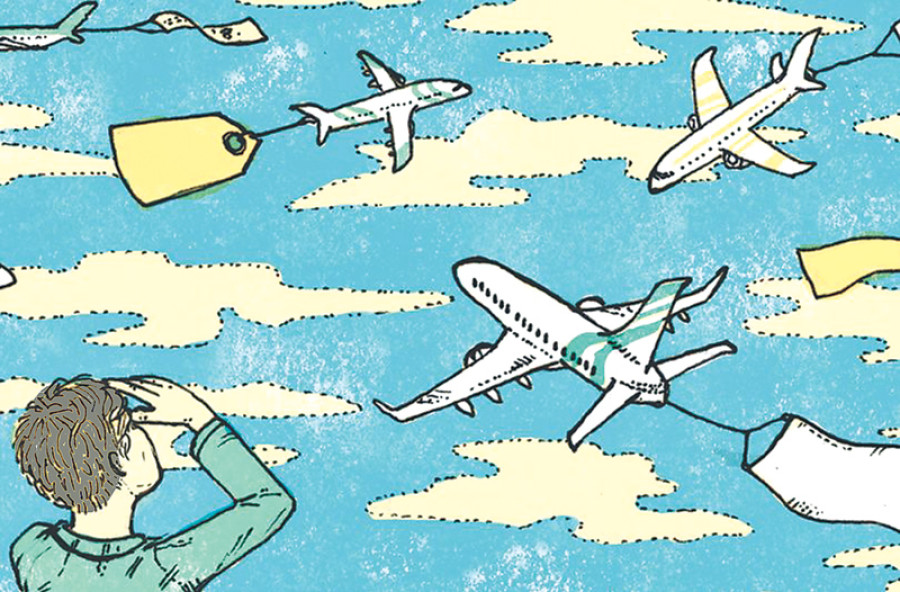Opinion
Price of the ticket
Dynamic pricing is followed globally, but in Nepal the government controls airfares
Rajin Ranjit
Computerised reservation systems were developed in the 1950s to keep track of airline seat booking and fare information. Initially they were internal systems, but were soon made available to travel agents. Their use spread rapidly after deregulation of airline pricing in the US in1978. The development of dynamically adjusted pricing is often credited to Robert Crandall of American Airlines as a response to the rise of discount airline PEOPLExpress in the early 1980s. The complexity and opaqueness of airline pricing has grown over time. As a result, the ‘yield management’ system employed by airlines for pricing has become one of the most arcane and complex information systems on the planet, and one with a very large economic component. Airline pricing represents a great challenge to modern economic analysis because it is so distant from the ‘law of one price’ level of analysis.
‘Dynamic pricing’, or setting flexible prices for products or services based on current market demand, has become common practice in several industries such as travel, entertainment and retail. This pricing strategy changes as per competitor pricing besides supply and demand. The aviation industry worldwide has been using this strategy to make sure that there is not a single unoccupied seat. This has strong correlation with yield management, and is the most sensitive and tough job today in aviation industry.
In Nepal, it is a different story altogether. The ministry and its relevant departments still control airline pricing systems. Since we moved into a new phase of electronic ticketing during the last decade, lots of changes have taken place in its mechanisms. We are slowly catching up with the global trend of dynamic fare mechanism but with restrictions fixed by the authorities. It is a common trend now to observe fare changes frequently. We will call the practice of charging different customers distinct mark-ups over marginal cost based on the time of purchase ‘dynamic pricing’ rather than ‘dynamic price discrimination’. Single class and fare systems on domestic trunk sectors are now on the verge of extinction. Every sector has its own set of classes with different fare categories and rules which have to be accepted by the passenger at the time of purchase.
It is a global practice and phenomenon to apply very strict rules and regulations to cheaper fares as compared to higher fares. Airlines in our country are facing sharp criticism over these issues. It is not uncommon for such issues to emerge while our mechanisation process is still in the primitive stage, and we are still adapting and trying to follow global trends. All mechanisms are in the restricted and controlled sphere of the authorities here in our context, and this has made it tougher to balance the two scenarios.
High competition
Is my price competitive? This is the key question that inventory managers and airline executives ask themselves every day. The Internet created price transparency on a scale unheard of in the past. Every client, even if he eventually buys his ticket from a travel agent, checks the Internet first or other available sources like mobile applications and SMS. Moreover, the competition is only a mouse-click away. This environment punishes uncompetitive airlines very quickly. In our context, uncompetitive airlines are those that do not react to market changes quickly and accurately resulting in low yield due to unoccupied seats. In the absence of a decisive support system, airlines will have to employ a high number of pricing analysts at much cost and without a guarantee that they will find all the relevant pricing changes, recommend the right decision and distribute price changes to all sales channels.
Most airlines accept a compromise between cost and benefit; they employ fewer pricing analysts, and as a result, have delayed and imperfect reactions to their competitors’ pricing changes. Generally, it is understood that designing a pricing strategy requires creativity which is an art in itself. Changes in consumer market trends, macroeconomic changes, market segmentation, airline revenue and profit force inventory managers to constantly monitor the effectiveness of their current pricing strategy and make timely adjustments. Consistent maintenance of an effective pricing strategy is not a simple task. The most common trap is straight pricing competition that not only hurts the individual airline but the industry as a whole.
National development
Inventory managers have to review several hundred daily price changes using very primitive transactional applications to find out what is happening in the market. Currently, the applications available with most airlines in our context do not have mechanisms to tailor price changes to the needs of individual analysts, do not provide decision support functionality and are not connected to the price change distribution systems. Hence, the necessity of employing an army of inventory managers who sift through daily price changes, make decisions (or recommendations) based on their knowledge and experience and pass them to another department for distribution.
Airlines have done a commendable job of catching up with global practices, and most importantly, providing sustainable and cheap fares to passengers to accelerate and boost the country’s economic development. We must admit that we are still very far behind in terms of global technology and methodology, and the authorities and policymakers should promote and back up the sincere efforts being made by airlines in this area so that the development of whole aviation industry will not suffer in the long run.
Ranjit is Director of Management Information System at Buddha Air




 18.12°C Kathmandu
18.12°C Kathmandu










